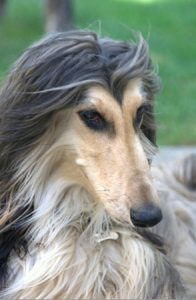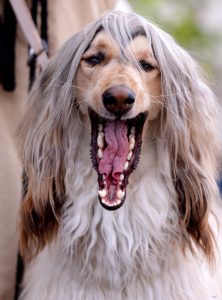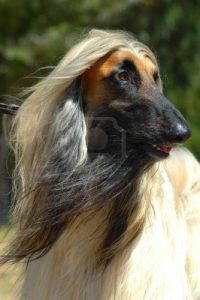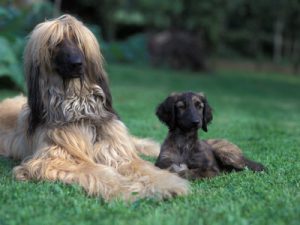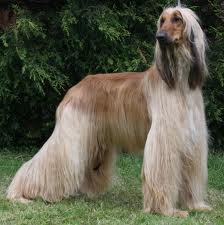Welcome to Afghan Hound Dogs and Puppies Central, the ultimate destination for lovers of this exquisite breed. Known for their elegance, beauty, and graceful demeanor, Afghan Hounds are one of the most ancient and distinguished dog breeds in the world. With their long, flowing coats, distinctive topknots, and aristocratic bearing, they have captured the hearts of dog enthusiasts everywhere. We are dedicated to celebrating and sharing all aspects of life with these remarkable dogs. Whether you’re a seasoned Afghan Hound owner or someone who’s just beginning to explore the world of these majestic animals, you’ll find a community and a wealth of resources to support your journey.
- Afghan Hounds
- All About Afghan Hound Dogs and Puppies
- Afghan Hound History
- Afghan Hound Appearance
- Afghan Hound Temperament
- Afghan Hound Exercise and Activity Needs
- Afghan Hound Grooming Tips
- Afghan Hound Nutrition and Feeding
- Afghan Hound Training Tips
- Afghan Hound Health Concerns
- Is an Afghan Hound Right For You?
- More Information about the Afghan Hound Dog Breed
Our platform offers comprehensive information, from the breed’s rich history and unique characteristics to the best practices in care, grooming, and training specifically tailored for Afghan Hounds. The breed, originally used for hunting large prey in the mountains and deserts of Afghanistan, has adapted to various roles in modern life, from show dogs to beloved family pets. At Afghan Hound Central, we understand the importance of maintaining the breed’s physical and mental well-being. Therefore, we provide insightful articles, tutorials, and expert advice to help owners ensure their Afghan Hounds live fulfilling, healthy lives. We also keep you updated on upcoming events, breed-specific shows, and activities where you can showcase your Afghan’s splendor and athletic prowess or simply enjoy the camaraderie of fellow Afghan Hound aficionados.
Beyond the wealth of knowledge, Afghan Hound Central is a vibrant community where passionate owners and breeders can connect and share their experiences. Through our forums and social media channels, members can exchange stories, seek advice, and celebrate their dogs’ milestones. For those interested in expanding their family with an Afghan Hound puppy, we provide a trusted platform to find reputable breeders and available litters. Our commitment to the breed’s welfare means we also support rescue operations and provide resources for adoption, ensuring that every Afghan Hound finds a loving, suitable home. Welcome to Afghan Hound Dogs and Puppies Central – your premier source for all things related to this noble and enchanting breed.
All About Afghan Hound Dogs and Puppies
Afghan Hound dogs are a breed known for their elegance, beauty, and distinctive flowing coats. Originating from the mountainous regions of Afghanistan, where they were bred for their superb hunting skills, Afghan Hounds were used by local tribes to chase down game over rugged terrain. Their long, silky hair, which served as protection against the harsh climate, and their keen sight made them excellent hunters of leopards and gazelles. Recognized by the American Kennel Club in 1926, the breed has since become a cherished companion and show dog, admired for its graceful demeanor and striking appearance.
Afghan Hound puppies, like all dogs, require early socialization and consistent training. They are known for their independent and sometimes aloof nature, which can be a challenge for first-time dog owners. Despite their regal appearance, they are playful and affectionate with their families. They possess a high prey drive, so it’s important to keep them on a leash or in a securely fenced area when outdoors. Afghan puppies grow into tall, lean adults, and maintaining their beautiful coat requires regular grooming. They benefit from a well-balanced diet and adequate exercise to keep them healthy and happy.
When considering adding an Afghan Hound to your family, it’s essential to understand the commitment to grooming and exercise this breed demands. Their long, fine hair can easily become matted without regular brushing, and they thrive on having space to run and stretch their legs. Moreover, these dogs are sensitive and respond well to gentle, positive training methods. Affectionate with their family members, they can be reserved around strangers. Afghan Hounds are not just pets; they are a statement of elegance and nobility, and they require owners who appreciate their unique characteristics and are willing to invest time in their care and training.
Afghan Hound History
Credit with the development of this fine and noble hound goes to the country of Afghanistan, though popular belief suggests that the Afghan Hound may have existed for thousands of years in the lands of Egypt. Another theory is that this elegant sighthound got his start on the steppes of Asia, where he might have evolved from an ancient sighthound in that territory.
Regardless of speculation and despite a lot of research going into these different theories, neither one has ever been proven and so, to date, it is generally acknowledged that this magnificent dog was developed in Afghanistan and surrounding countries, somewhere around the 19th century.
Created for the purpose of coursing game, the Afghan hound was not just a pretty face, back in the day. Used to hunt everything from common hares to the elusive snow leopard, Afghan Hounds were prized for their surefootedness, swiftness and their courage, as well as their beauty.
Capable of being hunted singly or in pairs or packs, the Afghan Hound was a formidable hunter, capable of bringing down large game with ease and yet these powerful dogs were almost wiped out during WWI.
Miss Jean C. Manson and the couple, Major and Mrs. G. Bell Murray, are responsible for reintroducing the Afghan hound to the Western world. Having just returned to Scotland after an 80-year trip to Baluchistan (now known as Pakistan), they brought with them a group of Afghans that they had both acquired and bred during their stay. Today, a majority of the modern Afghan Hounds can be traced back to dogs of their lineage.
Afghan Hound Appearance
The Afghan Hound possesses an unmistakable appearance that sets it apart from other breeds. With its refined and elegant head, the breed exhibits a level mouth, which is a specific trait where the upper and lower teeth align perfectly, a feature that is highly sought after in show dogs but can pose a breeding challenge.
The Afghan Hound stands tall and proud, with an average height ranging from 24 to 28 inches at the shoulder. Adult Afghan Hounds typically weigh between 50 and 60 pounds, striking a balance between grace and strength. While the breed standards allow for a variety of coat colors, white markings, especially on the head, are not preferred within the show ring, as they can detract from the breed’s distinctive appearance.
The Afghan Hound’s most defining feature is its luxurious, flowing coat, which stands in stark contrast to the short, fine hair found on the head, tail, and saddle area (the back portion between the rib cage and the hindquarters). The rest of the body is adorned with a long and silky coat that exhibits both feathering and density, adding to the breed’s aristocratic and dignified look. This coat is not only beautiful but also serves a functional purpose, providing insulation against both the cold and the heat, which is a nod to the breed’s origins in the mountainous regions of Afghanistan. The Afghan Hound’s grooming requirements are considerable; the coat must be kept clean and well-maintained to prevent mats and tangles, which can detract from its natural splendor.
When it comes to showing an Afghan Hound, the breed is presented in its most natural form, without any trimming or clipping that would alter its silhouette or the texture of its coat. This insistence on a natural presentation underscores the breed’s inherent beauty and the importance of maintaining breed standards.
The head of the Afghan Hound is particularly striking when adorned with an elegant topknot, which adds to the breed’s regal bearing. This topknot is the only acceptable form of “styling” for the breed in the show ring, ensuring that the Afghan Hound’s noble and exotic look is appreciated in its purest form, without unnecessary embellishments or alterations. The breed’s unique combination of elegance and athleticism has endeared it to dog lovers and connoisseurs of canine beauty around the world.
Afghan Hound Temperament
The Afghan Hound, with its regal posture and luxurious, flowing coat, is the embodiment of aristocratic elegance. This breed carries an air of dignity and noble detachment that sets it apart from many others. Originating from the mountainous regions of Afghanistan, where it was bred for its ability to hunt fast prey over rugged terrain, the Afghan Hound’s appearance is matched by a dignified and somewhat reserved personality. Its fine features and piercing gaze suggest an innate sophistication, and every aspect of this breed, from its high hipbones and unique ringtail to its long silky fur, reflects a distinctive, almost majestic beauty that captivates admirers and dog enthusiasts alike.
Despite their beauty and elegance, Afghan Hounds are known for being aloof and somewhat introverted. They do not typically seek the constant attention or social engagement that some other breeds crave. Instead, they often prefer the serenity of their own company or the quiet companionship of their family. These dogs have a sensitive nature, which can sometimes manifest as shyness or reticence in boisterous environments. Their tendency to remain on the periphery of activity makes them more likely to observe from a distance rather than participate in the midst of a chaotic setting, such as a family gathering or a crowded event. This characteristic can be both charming and challenging, requiring owners to understand and respect their need for personal space.
When it comes to festive occasions like Christmas parties, an Afghan Hound would typically choose the calm underneath a table over the hustle and bustle of the celebration. The noise and excitement of gatherings with loud relatives and energetic children can be overwhelming for these sensitive dogs. As a responsible and caring owner, it is important to acknowledge this preference by providing a peaceful sanctuary for your Afghan Hound. A quiet retreat, away from the clamor, would be greatly appreciated by your companion. This not only demonstrates empathy towards your pet but also reinforces the bond of trust between you, ensuring your Afghan Hound feels secure and loved even amidst the festivities he would rather watch from a comfortable and serene distance.
Afghan Hound Exercise and Activity Needs
Despite their elegant appearance and regal bearing, often depicted in movies as lounging gracefully in luxurious apartments, Afghan Hounds are not the best fit for the confined spaces of New York City living. Originating from the mountainous regions of Afghanistan, these dogs have been bred for their stamina and speed, with a natural inclination for vigorous activity. Their long, silky coats and dignified demeanor may give off the impression of a sedentary lifestyle, but in truth, Afghan Hounds thrive when they have ample space to roam and run. The constraints of a small apartment can lead to a host of behavioral and health issues for a breed that is innately programmed for more expansive environments.
For the Afghan Hound, regular exercise is not just a preference—it’s a necessity. In the absence of a spacious fenced backyard where they can sprint and explore to their heart’s content, these dogs require dedicated exercise time to sustain their physical and mental well-being. Owners must be willing to commit to multiple half-hour walks each day to fulfill the breed’s need for activity. These walks are not mere leisurely strolls but should be brisk and purposeful, allowing the Afghan Hound to stretch their long limbs and maintain their lithe muscle structure. Without this commitment to their exercise regimen, Afghan Hounds can become restless and may exhibit unwanted behaviors as a result of their unspent energy.
Understanding an Afghan Hound’s need for exercise is crucial for anyone considering this breed as a pet, especially in a bustling urban environment like New York City. While these dogs can adapt to various living situations, their quality of life is greatly enhanced by access to open spaces. In urban settings, this may mean frequent visits to dog parks or long walks in areas where they can safely run and play. Prospective Afghan Hound owners must be realistic about the level of activity they can provide for their pet and should consider whether their living arrangements can accommodate the needs of this active and athletic breed. Ensuring that these beautiful canines receive the exercise they require is essential to their happiness and health, making them more suitable for suburban or rural settings where space is more readily available.
Afghan Hound Grooming Tips
The Afghan Hound, with its majestic appearance, is a breed known for its thick, flowing coat that can be the envy of many dog enthusiasts. To maintain the breed’s distinct elegance, regular grooming is essential, and this includes a daily comb-through. This practice not only keeps the coat free from snarls and mats but also ensures that the hair remains silky and lustrous. The combing process should be gentle and thorough, as the Afghan Hound’s coat can be quite delicate. Owners must invest in the right grooming tools, like a wide-toothed comb or a slicker brush, to detangle the hair without causing discomfort or damage to the dog’s skin.
Bathing an Afghan Hound should be done with care, as their hair can easily become dry and brittle if washed too frequently or with harsh shampoos. While the frequency of baths largely depends on the dog’s lifestyle and the owner’s preferences, show Afghan Hounds often require more frequent bathing to maintain their show-worthy condition. Weekly or bi-weekly baths using high-quality, dog-appropriate shampoos and conditioners can help to keep their coat in top shape, ensuring it’s clean and free of any residue that could weigh it down. It’s also crucial to thoroughly dry their long hair post-bath to prevent any dampness from causing skin issues or matting.
Finding the right balance for grooming and bathing routines is a personalized process that will vary from one Afghan Hound to another. Dogs that enjoy outdoor adventures might need more frequent bathing, while those who prefer the comforts of indoors may not get dirty as often. Regardless, establishing a consistent grooming routine early on is key to keeping an Afghan Hound’s coat manageable and beautiful. Owners should take the time to understand their pet’s needs and preferences, and with patience and regular care, they can ensure their Afghan Hound remains a stunning example of the breed. A well-groomed Afghan Hound is not only a pleasure to look at but also a happier, healthier companion.
Afghan Hound Nutrition and Feeding
Afghan Hounds are a distinctive and elegant breed, known for their long, flowing coats and aristocratic demeanor. When it comes to their nutrition, it’s essential that they are provided with a well-balanced diet that meets their specific needs. As a breed, Afghan Hounds are typically active and require a diet rich in proteins to support muscle maintenance and repair. High-quality commercial dog foods that list real meat as the first ingredient are often a good choice. Additionally, because of their long coats, Afghan Hounds can benefit from foods that contain essential fatty acids like omega-3 and omega-6, which can help maintain the health and sheen of their luxurious fur. It’s also important to note that Afghan Hounds can be prone to allergies, so a diet that avoids common allergens such as corn, wheat, and soy may be beneficial for sensitive dogs.
Feeding an Afghan Hound requires attention to their life stage and activity level. Puppies, with their rapid growth rates, need more calories and nutrients in proportion to their body weight than adult dogs. A puppy formula or an all-life-stages food is often recommended until they reach maturity, at which point they can transition to an adult maintenance formula. For senior Afghan Hounds, a diet lower in calories but still rich in high-quality proteins can help maintain their lean muscle mass while preventing unwanted weight gain. Moreover, because Afghan Hounds are deep-chested, they may be more susceptible to bloat, a condition that can be alleviated by feeding smaller, more frequent meals rather than one or two large meals per day.
In addition to the type of food, feeding an Afghan Hound also requires consideration of the method and environment. Elevated feeding stations can help facilitate easier swallowing and digestion, which is particularly beneficial for this tall breed. Fresh, clean water should always be available, and the feeding area should be calm and free from distractions to encourage proper eating habits. Treats can be a useful tool for training or rewarding good behavior, but should be given in moderation to avoid obesity. Regularly monitoring the Afghan Hound’s weight and body condition is crucial, and adjustments to their diet should be made accordingly, in consultation with a veterinarian or a canine nutritionist, to ensure the dog remains at an optimal weight and health status.
Afghan Hound Training Tips
Afghan Hounds are one of the most ancient and distinctive dog breeds, with their elegant build and luxurious silky coats. Like cats, they are known for their independent and somewhat aloof personality, which can be a charm for some owners and a challenge for others. This feline-like demeanor extends to their approach to learning and training. Afghan Hounds are not ones to seek constant approval from their humans, as many other dog breeds might. Instead, they possess a self-sufficient streak that often leads them to make their own decisions about whether or not they want to engage in a task. This can make training sessions interesting, to say the least, as an Afghan Hound may choose to simply ignore commands if they don’t see a direct benefit or interest in them.
Training an Afghan Hound requires a unique approach compared to more eager-to-please breeds. Their stubborn nature means that traditional methods of training that rely heavily on repetition and dominance can backfire, leading to a standoff between dog and owner rather than a learning experience. It’s not that Afghan Hounds can’t learn; in fact, they are quite intelligent. However, their intelligence is coupled with a strong will, which means they need to be convinced that the training is worth their time. Positive reinforcement, along with a good dose of creativity and fun, can entice an Afghan Hound to participate more willingly. The key is to make the learning process enjoyable and rewarding for them without turning it into a battle of wills.
Patience and persistence are indeed virtues when it comes to training an Afghan Hound. Their tendency to walk away from a training session that doesn’t interest them can be frustrating for an owner who is accustomed to more compliant breeds. But with a calm and consistent approach, along with an understanding of the breed’s personality, it is possible to engage an Afghan Hound in learning. It’s important to set realistic expectations and to celebrate small victories. Owners who appreciate the breed’s unique characteristics and who can adapt their training style to fit the Afghan’s independent nature often find great joy and companionship in their regal pets. After all, the bond that slowly forms through this patient and persistent training can lead to a deeply loyal and enriching relationship between an Afghan Hound and its owner.
Afghan Hound Health Concerns
Afghan Hounds, known for their distinctive elegance and flowing coats, are not exempt from genetic and health concerns that can affect their quality of life. When considering adding an Afghan Hound puppy to your family, conducting thorough research and engaging with reputable breeders is crucial. These breeders should have a transparent approach to the health of their dogs, offering potential owners detailed histories of their breeding lines. Prospective owners should inquire about health clearances and any genetic testing the breeder has conducted. It is essential for breeders to be knowledgeable about the breed-specific ailments and to provide evidence of the health status of the puppy’s parents, the sire and dam, to ensure the best start for the new addition to your home.
Among the health issues that may affect Afghan Hounds, hip and elbow dysplasia are two of the most common concerns. These are hereditary conditions where the respective joints develop abnormally, which can lead to pain, lameness, or arthritis over time. To mitigate these risks, breeders should have their dogs evaluated by a veterinarian and certified by an organization such as the Orthopedic Foundation for Animals (OFA). Prospective Afghan Hound owners should be proactive in asking breeders for certification that the parents of their puppy are free of these dysplasias. Additionally, a well-thought-out diet and appropriate exercise regimen are vital in maintaining joint health and preventing excessive strain on the developing skeletal system of a young Afghan Hound.
Cataracts and necrotic myelopathy are two other health issues that can affect Afghan Hounds. Cataracts can cause cloudiness in the lens of the eye, leading to impaired vision and potentially blindness if left untreated. Regular veterinary eye exams can detect cataracts early, and surgical options are available to restore vision in affected dogs. Necrotic myelopathy, a less common but severe condition, affects the spinal cord, leading to progressive paralysis. There is no cure for necrotic myelopathy, but early detection and supportive care can help manage the symptoms. When selecting an Afghan Hound puppy, it is wise to ask breeders about the history of these conditions in their lines and the measures they take to avoid them. In doing so, new owners can better prepare for and potentially avoid the heartache of dealing with such challenging health issues.
Is an Afghan Hound Right For You?
The Afghan Hound stands as one of the most ancient and distinctive dog breeds, boasting a regal presence that is hard to ignore. These dogs are not the typical cuddle companions that some might seek in a pet; instead, they carry a dignified and independent spirit that sets them apart from more affectionate breeds.
Known for their long, silky coats and aristocratic bearing, Afghan Hounds are not the type to fawn over their owners or seek constant physical attention. They tend to maintain a certain distance, much like a cat might, displaying an almost majestic indifference that is mistaken by some as arrogance. However, for enthusiasts who admire their unique temperament, Afghan Hounds offer a blend of intelligence and beauty that is deeply rewarding.
Those drawn to the Afghan Hound often have a deep appreciation for the breed’s striking physical attributes and complex personality. With their slender build, profound gaze, and flowing locks, these dogs exude an air of elegance and poise that is unmatched. Their intelligence is subtle yet sharp, manifesting not in eager-to-please obedience but in a thoughtful and discerning manner. This independence means they are less likely to exhibit clingy behavior or require constant attention, making them well-suited for individuals who respect a pet with a strong sense of self.
While they may not be the quintessential lapdog, their majestic demeanor and independent nature offer a different kind of companionship that many find captivating.
Living with an Afghan Hound does come with its set of challenges and responsibilities, particularly in terms of grooming. Their luxurious coat is a hallmark of the breed, but it demands daily brushing to maintain its luster and prevent mats or tangles. This daily ritual can be a time for bonding, albeit on the Afghan’s terms.
Those willing to invest the time and effort into their care will find that Afghan Hounds make an elegant and intriguing addition to the household. They may not be the dog for everyone, but for those who resonate with their unique character, sharing a home with an Afghan Hound can be a truly distinctive experience, filled with moments of quiet companionship and the pleasure of observing one of the canine world’s most splendid creations.
More Information about the Afghan Hound Dog Breed


